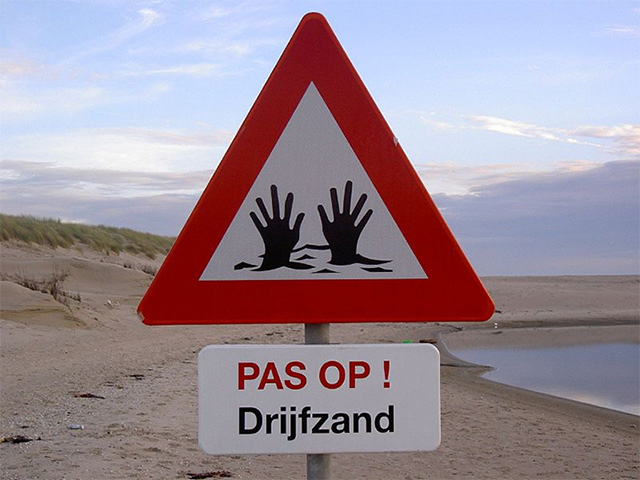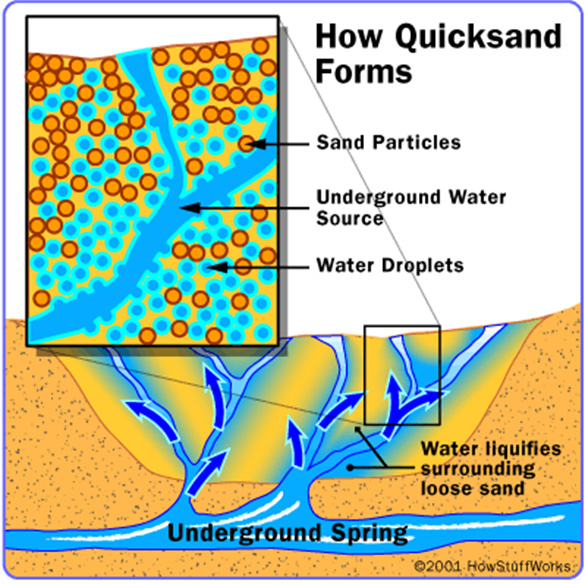
Getting caught in quicksand can be fatal, with victims dying mostly from dehydration, hypothermia or heat exhaustion.
What can you do to avoid getting trapped—and to escape if you do?
It starts by knowing where quicksand forms and what it looks like.
Quicksand is just super-saturated sand. Normal wet sand is about 25 percent water; quicksand is more than 70 percent.
Quicksand can form on beaches, tidal flats, riverbanks or near springs—anywhere the ground is saturated with water.
In those places, look out for sand that’s spongy or rippled in appearance, and check suspicious areas with a stick.
Quicksand looks solid, and if you were to place something or even step lightly upon it, it may support you.
But step firmly and the quicksand will liquefy, and you’ll sink. Because humans are buoyant, we typically won’t sink below the waist or mid-chest.
But once the sand grains are out of liquid suspension, they too will sink, and compact around your legs, trapping you.
The more you struggle, the more sand will liquefy and sink, and the more trapped you’ll become.
The key to getting out is to remain calm.
Lie back in slow motion. Wiggle your legs in tiny movements, which will slowly let water in to loosen the compacted sand. Then gradually recline to float on the surface.
Once free, you can slowly crawl or swim to the edge and roll onto solid ground.
Background
Synopsis: From Oscar-winning films like Lawrence of Arabia to TV episodes of Lassie and Tarzan, the hazard of quicksand fascinated viewers of the mid-20th century so much that 3% of films of that time included someone sinking inexorably into the earth. But what is quicksand and can you really be swallowed alive by it?
- Once moving pictures were invented, filmmakers looked for dramatic situations to record, and images of quicksand struggles became popular.
- The first film to use quicksand dramatically was made in 1909. Rescued from Quicksand—the story of the rescue of a young woman from quicksand on a beach by monks from a local monastery—lasted 12 minutes.
- The peak of quicksand-related films occurred in the 1960s when one out of 33 films (3%) included some sort of a quicksand hazard.
- After the 1960s, quicksand was used more as a comedic or ironic device, such as in Blazing Saddles and Indiana Jones and the Kingdom of the Crystal Skull.
![Quicksand in Courthouse Wash at Arches National Park in Utah. Credit: Arches National Park [Public domain]](/files/inline-images/ED145_002.jpg)
Quicksand in Courthouse Wash at Arches National Park in Utah. Credit: Arches National Park [Public domain] - What is quicksand?
- Quicksand is a colloid hydrogel made up of loosely packed granular material that is saturated with water, creating a suspension.
- It is a “shear thinning non-Newtonian fluid,” meaning that when undisturbed, the hydrogel looks solid, but just 1% change in stress will cause a sudden decrease in viscosity, or fluidization.
- Where do you find quicksand?
- Natural springs can cause quick conditions to occur in alluvial fans or along riverbanks.
- The force of shaking during earthquakes may increase groundwater pore pressure and trigger liquefaction of surface sand or silt, causing building foundations to shift.
- Quick conditions may occur on beaches and tidal flats during low tides as the retreating sea leaves behind saturated sand.
- Desert quicksand (with air-filled voids) may occur on the downwind side of dunes, but usually only a couple inches of sinking occurs in these cases, as the air is quickly expelled when the sand compacts under a load or vibration.
- How do you get stuck in it?
- Normal sand is packed together with about 25-30% of void space between the grains, but in quicksand, grains are more loosely packed with 30-70% porosity. The volume of water-filled void space is often greater than the volume of grains.
- If gently placed on quicksand, even dense materials will rest on the surface.
- The sand becomes “quick” when motion, loading, vibration or upward migration of water breaks down the friction that holds the grains in place. The more stress, the more fluidized quicksand becomes.
- The sand rapidly separates from the water and is redeposited as denser, more viscous sediment, trapping victims in newly reorganized tightly packed sand.
- How can you escape it?

Quicksand forms when water-saturated sand is agitated, breaking down frictional forces so that it is no longer able to support weight. Credit: How Quicksand Works | HowStuffWorks.com - Relax: The more you struggle, the more fluid the quicksand will become, and the faster you will sink. Get rid of extra weight like backpacks that make you sink more.
- Remember that when liquefaction ends, the redeposited sand will be packed more densely around you. Any movement will create a vacuum. Lifting a foot directly out of quicksand may require as much force as lifting a small car.
- Lean back in slow motion to spread out your body weight: Like in a swimming pool, you will be able to float at a safe level if you are horizontal.
- Move slowly and wiggle your legs repeatedly to create voids around them that water can flow into, loosening the sand progressively until you can pull them out.
- Crawl or paddle slowly to safety, then roll yourself onto solid ground.
- Leave your shoes behind if necessary.
- Do people really die by being sucked into quicksand and drowning?
- People don’t get sucked below the surface of quicksand because they are too buoyant; humans are about half as dense as quicksand. Even in the deepest quicksand pools, people probably only sink in to their waists or lower chest.
- Deaths from quicksand encounters have occurred, however, when people became trapped and died of exposure, dehydration, hypothermia or heat exhaustion.
- Injuries and deaths by animal attacks and drowning by inundation during high tide have also occurred.
- To be safe when hiking, beware of ground that may be spongy or rippled in appearance, and test the competence of the ground along your path using a walking stick.

